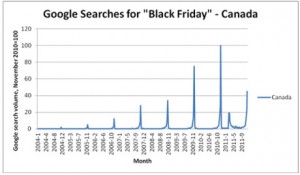Black Friday has been an American tradition since the beginning of American consumerism, however, recent trends show that the increasing Canadian dollar have made Black Friday canadian pastime, if only for those close to the border.
Consumer have always known that shopping in the United States can lead to saving, but the recent increases in the dollar has seen more and more Canadians crossing the border to do even their most simple shoppings. This shopping pattern is exemplified even more in the American shopping holiday of Black Friday, where deals and sales leave shoppers with even more savings.
However, though this may be good for Canadian consumers, retailers and stores are suffering as the continue to fail to compete with american prices. Canadians are exercising their buyer power. Retailers have no way of stopping those who choose to cross the border, if the canadian dollar continues to rise in the long term, they may be forced change their prices to compete with american prices.
Nevertheless, retailers are unlikely to change. There are already regulations in place that limit the amount a citizen can bring back into the country and only a dramatic change might distort the market enough to impact price difference between Canada and the United States.




